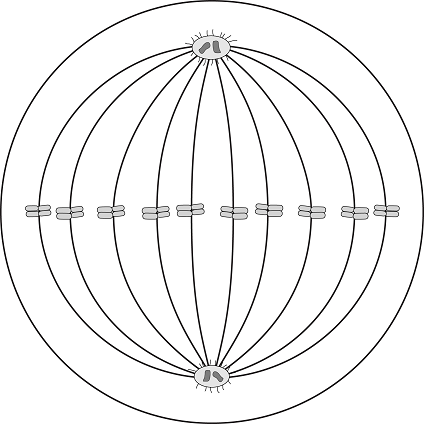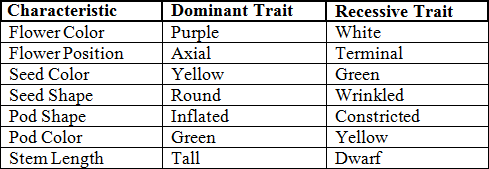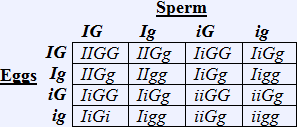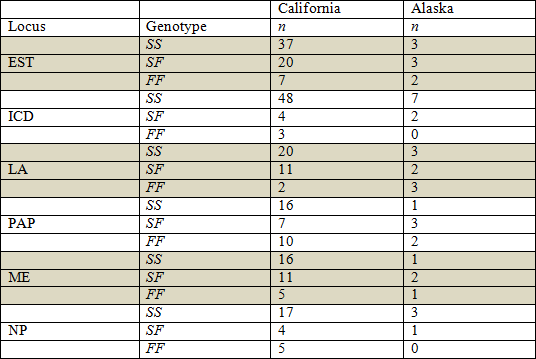Congratulations - you have completed .
You scored %%SCORE%% out of %%TOTAL%%.
Your performance has been rated as %%RATING%%
Your answers are highlighted below.
Question 1 |
In order for an animal mutation to affect a population’s genetic diversity, the mutation must take place:
In the somatic cells | |
During prophase | |
In the gametes | |
During telophase |
Question 1 Explanation:
The correct answer is (C). In animals, mutations that take place in cells which are not involved in producing gametes (intestinal cells, for example) will be lost when the individual dies, and not passed on to offspring. In order for the mutation to be passed down to offspring, it must affect the gametes.
Question 2 |
Questions 2–4

Swamp wallabies have 10 chromosomes during this phase. How many chromosomes did the wallaby inherit from each parent?
10 | |
5 | |
20 | |
15 |
Question 2 Explanation:
The correct answer is (B). Somatic cells, like the one pictured here in metaphase, are diploid. If the diploid number is 10, then the organism inherited 5 chromosomes from each parent (the haploid number).
Question 3 |

How many chromosomes are in each of the wallabies' gametes?
10 | |
5 | |
20 | |
15 |
Question 3 Explanation:
The correct answer is (B). Sex cells (gametes) have half the number of chromosomes as somatic cells.
Question 4 |

How many chromosomes will be in each of the wallaby’s offspring?
10 | |
5 | |
20 | |
15 |
Question 4 Explanation:
The correct answer is (A). Offspring have the same number of chromosomes as their parents.
Question 5 |
Which types of organisms have a sexual life cycle known as the alternation of generations?
Animals | |
Plants and fungi | |
Bacteria | |
Archaea |
Question 5 Explanation:
The correct answer is (B). Alternation of generations is a type of life cycle in which both diploid and haploid stages are multicellular. The sporophyte generation produces a gametophyte as its offspring and the gametophyte generation produces the next sporophyte generation.
Question 6 |
During metaphase I of meiosis I, homologous pairs of chromosomes are situated along the metaphase plate. The orientation of each pair is random, resulting in a 50% chance that a particular daughter cell will get the maternal chromosome and a 50% that the daughter cell will get the parental chromosome. This is one aspect of sexual reproduction that contributes to genetic variation, and is called:
Independent assortment | |
Separation of homologs | |
Cytokinesis | |
Reductional division |
Question 6 Explanation:
The correct answer is (A). Since each homologous pair of chromosomes is positioned independently of the other pairs, the division at the end of meiosis I results in each pair sorting its maternal and parental homologs into daughter cells independently.
Question 7 |
During prophase I of meiosis, a reciprocal exchange of genetic material between nonsister chromatids producing chromosomes with new combinations of material and parental alleles. This is called:
Synapsis | |
Crossing over | |
Codominance | |
Reductional division |
Question 7 Explanation:
The correct answer is (B). Crossing over begins in prophase I when homologus pairs of chromosomes pair loosely along their lengths. The genes on each homolog are precisely aligned with the corresponding gene on the other homolog. Proteins facilitate the swaping of corresponding segments of two nonsister chromatids to result in new combinations of maternal and parental alleles.
Question 8 |
When hybrids are less fit than members of their parent species, natural selection may strengthen prezygotic barriers, and therefore reduce the formation of unfit hybrids. Which of the following is an example of strengthening reproductive barriers during hybridization?
Two hundred of the former 600 species of cichlids in Lake Victoria have vanished over the past 30 years. Water pollution caused the water to become murky, reducing the ability of the females to use color to distinguish males of their own species. This is resulted in an increased frequency of mating between members of species that had formerly been isolated reproductively. Consequently, many hybrids have been produced, and many of the former parent species have been lost. | |
Two species of toads in genus Bombina have produced hybrid toads with increased rates of embryonic mortality and abnormality, such as ribs fused to the spine and malformed mouthparts in the tadpoles. The hybrids have poor survival and reproduction and produce few viable offspring with members of the parent species. | |
In the Appalachian Mountains, two species of ground crickets have formed hybrids where the two species are closely interspersed. The fitness of the hybrid varies from year to year and sometimes exceeds the fitness of both parent species. | |
Heliconius butterflies in the Amazon breed with other species within the same genus, resulting in a hybrid with more distinctive colors. The distinctive colors warn birds that these butterflies contain cyanide, thus strengthening the survival abilities of the butterflies. |
Question 8 Explanation:
The correct answer is (B). Since the hybrids of the toads do not survive to pass on their genes, the reproductive barriers are strengthened, or reinforced.
Question 9 |
Which of the following is not a difference between the cell cycle and meiosis?
The cell cycle produces cells for growth and repair. Meiosis produces gametes. | |
Cells divide one time in the cell cycle. Cells divide two times in meiosis. | |
The cell cycle produces cells genetically identical to the parent cell. Meiosis produces cells genetically different from the parent and from each other. | |
In the cell cycle, crossing over takes place during metaphase. In meiosis, crossing over takes place during prophase I. |
Question 9 Explanation:
The correct answer is (D). Crossing over only takes place during meiosis.
Question 10 |
Questions 10–11

Pea plants heterozygous for pod shape and pod color were allowed to self pollinate, and 400 resulting seeds were planted. How many offspring would be predicted to have constricted and yellow?
16 | |
25 | |
75 | |
225 |
Question 10 Explanation:
The correct answer is (B). First define the variables and then create a chart:
Inflated Pod Shape = I
Constricted Pod Shape = i
Green Pod Color = G
Yellow Pod Color = g
Cross: IiGg x IiGg

Inflated and Green: 9/16
Inflated and Yellow: 3/16
Constricted and Green: 3/16
Constricted and Yellow: 1/16
1/16 of 400 = 25
Inflated Pod Shape = I
Constricted Pod Shape = i
Green Pod Color = G
Yellow Pod Color = g
Cross: IiGg x IiGg

Inflated and Green: 9/16
Inflated and Yellow: 3/16
Constricted and Green: 3/16
Constricted and Yellow: 1/16
1/16 of 400 = 25
Question 11 |

How many different gametes could be made from a pea plant heterozygous for flower color, flower position and stem length?
27 | |
6 | |
8 | |
64 |
Question 11 Explanation:
The correct answer is (C).
Purple Flower Color = P
White Flower Color = p
Axial Flower Position = A
Terminal Flower Position = a
Tall Stem Length = T
Dwarf Stem Length = t
Gametes are as follows: PAT, PAt, PaT, Pat, pAT, pAt, paT, pat
Purple Flower Color = P
White Flower Color = p
Axial Flower Position = A
Terminal Flower Position = a
Tall Stem Length = T
Dwarf Stem Length = t
Gametes are as follows: PAT, PAt, PaT, Pat, pAT, pAt, paT, pat
Question 12 |
Duchenne muscular dystrophy affects 1 in 3,500 males born in the United States. This disease is characterized by the progressive loss of coordination and weakening of the muscles, and those with Dushcenne muscular dystrophy have a shorter than average lifespan. This disorder was traced to the absence of a muscle protein called dystrophin, for which the gene is located on X chromosome.
This gene is an example of:
An X inactivation | |
A barr body | |
A sex-linked gene | |
Recombination |
Question 12 Explanation:
The correct answer is (C). Sex-linked genes are any genes located on a sex chromosome. In humans, such genes are often found on the X chromosome.
Question 13 |
Sexual reproduction produces variation within populations through which mechanism(s)?
Crossing over | |
Independent assortment of homologous chromosomes | |
Random fertilization | |
All of the above |
Question 13 Explanation:
The correct answer is (D). Crossing over contributes to genetic variation through the exchange of genetic material between non-sister chromatids of homologous chromosomes during meiosis. During metaphase I of meiosis, homologous pairs of chromosomes line up along the metaphase plate and can be oriented in 2 different ways. The random way in which the homologous pairs line up and then are separated into separate cells will create variety among the gametes. Finally, the random fertilization of gametes will also affect the variety of the offspring.
Question 14 |
Questions 14–15
Lidicker and McCollum (1997) examined genetic variation in two populations of sea otters in the eastern Pacific. Before fur hunting led to their near extinction, sea otters were distributed throughout the region. Along the central California coast, it is estimated that only one population of 50 or fewer individuals survived. Since this population was protected in 1911, it has grown to over 1500 otters. The population may have lost considerable genetic variation due to the extreme reduction in population size. A population from Alaska experienced a similar bottleneck around that time, but it was not as severe.
One way to look at genetic diversity is to study the allele and genotype frequencies of allozymes. Allozymes are enzymes that show different rates of movement in gel electrophoresis due to the presence of different alleles at a single locus, whereas F is the fast-moving allele, and S is the slow-moving allele. The table below shows the number of individuals with a given genotype for six variable (polymorphic) two-allele loci:
One way to look at genetic diversity is to study the allele and genotype frequencies of allozymes. Allozymes are enzymes that show different rates of movement in gel electrophoresis due to the presence of different alleles at a single locus, whereas F is the fast-moving allele, and S is the slow-moving allele. The table below shows the number of individuals with a given genotype for six variable (polymorphic) two-allele loci:

We can use these data to calculate the allelic frequencies for a given locus, such as the ME locus in the California population. How many S alleles are there in the population?
43 | |
21 | |
32 | |
27 |
Question 14 Explanation:
The correct answer is (A). Each individual with the genotype SS has two copies of the S allele;
therefore the 16 individual with this genotype have a count of 32 S alleles. The
heterozygote individuals (SF) have one of each allele, so there are 11 S alleles and 11 F
alleles among them, bringing the total of S alleles to 43 (16 + 16 + 11).
Question 15 |
Lidicker and McCollum (1997) examined genetic variation in two populations of sea otters in the eastern Pacific. Before fur hunting led to their near extinction, sea otters were distributed throughout the region. Along the central California coast, it is estimated that only one population of 50 or fewer individuals survived. Since this population was protected in 1911, it has grown to over 1500 otters. The population may have lost considerable genetic variation due to the extreme reduction in population size. A population from Alaska experienced a similar bottleneck around that time, but it was not as severe.
One way to look at genetic diversity is to study the allele and genotype frequencies of allozymes. Allozymes are enzymes that show different rates of movement in gel electrophoresis due to the presence of different alleles at a single locus, whereas F is the fast-moving allele, and S is the slow-moving allele. The table below shows the number of individuals with a given genotype for six variable (polymorphic) two-allele loci:
One way to look at genetic diversity is to study the allele and genotype frequencies of allozymes. Allozymes are enzymes that show different rates of movement in gel electrophoresis due to the presence of different alleles at a single locus, whereas F is the fast-moving allele, and S is the slow-moving allele. The table below shows the number of individuals with a given genotype for six variable (polymorphic) two-allele loci:

The number of S alleles in the California population at the EST locus is 94, and the number of F alleles is 34. If this population is in Hardy-Weinberg equilibrium, what would be the expected genotype frequencies for SF for the EST locus in the California population?
0.539 | |
0.390 | |
0.071 | |
0.266 |
Question 15 Explanation:
The correct answer is (B). First, it is necessary to calculate the allelic frequencies by dividing the
number of S or F alleles by the total number of alleles: 94/128 = 0.734 = p = frequency of the S allele, and 34/128 = 0.266 = q = frequency of the F allele. If the population is in
Hardy-Weinburg equilibrium, we would expect the genotype frequency for SF = 2pq =
2(0.734)(0.266) = 0.390.
Question 16 |
Which of the following is not a correct condition for Hardy-Weinberg equilibrium to be met:
No mutations | |
No gene flow | |
No natural selection | |
Selective mating |
Question 16 Explanation:
The correct answer is (D). If individuals mate preferentially within a population, random mixing of gametes will not occur and the genotype frequencies change.
Question 17 |
In a typical human cell, only about 20% of the genes it contains are expressed (even less in muscle and nerve cells), even though almost all the cells in the organism contain the same DNA. The set of genes expressed in each cell is unique, which allows the cells to perform different functions.
This expression of different genes by cells within the same genome is known as:
Positive gene regulation | |
Negative gene regulation | |
Differential gene expression | |
Genomic imprinting |
Question 17 Explanation:
The correct answer is (C). Positive and negative gene regulation are used by bacteria to respond to environmental change. Genomic imprinting takes place when the expression of an allele is determined by which parent the gene was inherited from.
Question 18 |
Which statement best describes when the role of the tryptophan operon when adequate tryptophan is present in the cell?
The repressor is inactive and the operon is turned “off,” haulting the production of tryptophan | |
Tryptophan acts as a corepressor and activates the repressor, stopping the production of tryptophan | |
The repressor becomes active, the operon is turned “on” and tryptophan is produced | |
Tryptophan is present, the repressor is active, and the operon is turned “on” |
Question 18 Explanation:
The correct answer is (B). The tryptophan operon is a repressible operon. When there is enough tryptophan in the cell, tryptophan acts as a corepressor and activates the repressor, changing its shape. The activated receptor binds to the operator and prevents the RNA polymerase from binding to the repressor and stops transcription. The tryptophan operon is a repressible operon, and therefore it is always switched on unless the repressor is activated.
Question 19 |
Most heritable variation involves characteristics that vary along a continuum within a population. These characters are referred to as:
Quantitative characters | |
Discrete characters | |
Hereditary characters | |
Heterozygous characters |
Question 19 Explanation:
The correct answer is (A). Quantitative characters are ones that exhibit a continuous distribution. Such characters are often the result of polygenic inheritance.
Question 20 |
The ABO blood groups in humans are determined by the following alleles of a single gene: IA, IB, and i. The four blood types, A, B, AB and O are determined by which genes are inherited from the parents. This pattern of inheritance pattern is called:
Pleiotropy | |
Epistasis | |
Multiple alleles | |
Codominance |
Question 20 Explanation:
The correct answer is (C). Multiple alleles exist when more than two alleles exist for a gene.
Once you are finished, click the button below. Any items you have not completed will be marked incorrect.
There are 20 questions to complete.
|
List |
Next Practice Test:
Gene Expression & Regulation >>
AP Biology Main Menu >>
